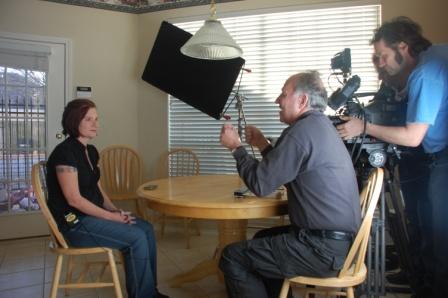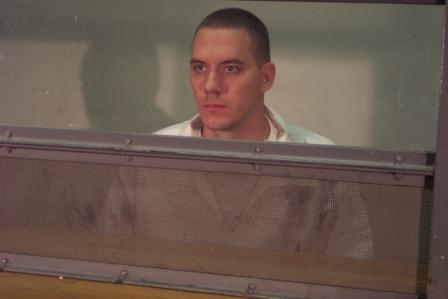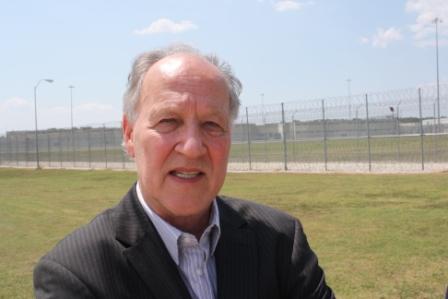Werner Herzog's 2011 documentary, Into the Abyss was my favorite film at this year's Thessaloniki Documentary Festival. In 2001, two teenaged boys in Texas, from what seems a red-neck town (a nearby town is called "Cut and Shoot"), took a liking for a red camaro, and decided to kill the woman who owned it (Sandra Stotler) so they could take a drive. After killing her in the hall of her home, they realized they didn't have the keys to the garage. So they waited for the son to come home, who had the keys, ambushed him and killed him and a friend as well. Then they drove the car off to a bar to show it off.
 Michael Perry, a week before execution Like a philosophical essay, the documentary is structured into six different sections, each with an evocative title such as, "Time and Emptiness." The film consists basically of interviews with the killers (one, 28-year-old Michael Perry, a week before he is to be executed), the victims' relatives, various down-and-out members of the community (including a machinist in a Red Bull cap who explains nonchalantly that he too was almost killed one afternoon by buddy Perry), a reflective reverend and, most provocatively, the captain of the capital punishment "Death House." Throughout one hears Herzog's gentle German-accented voice, asking questions in a kind loving tone. His last line to the killer Michael Perry -- en route to execution -- is "I wish you all the best." Each interview is shot with Herzog's masterful skill, well-known from his fiction films: wide-angle frames which show not only the person speaking, but his or her environment. One boy speaks about his hard childhood, growing up poor with thugs around him, father in prison, while we spot a child's swing set behind him. The newly pregnant wife of one of the killers (Jason Burkett: they met through correspondence), enthuses about her husband's "beautiful hands" and recounts the story of how a rainbow stretched miraculously across the prison gates when she first met him -- while a baby's highchair is posed behind her in the kitchen. The interviews themselves are interspersed with long shots of Texan roads, with eerie music and an occasional shot at ominous birds.
Michael Perry, a week before execution Like a philosophical essay, the documentary is structured into six different sections, each with an evocative title such as, "Time and Emptiness." The film consists basically of interviews with the killers (one, 28-year-old Michael Perry, a week before he is to be executed), the victims' relatives, various down-and-out members of the community (including a machinist in a Red Bull cap who explains nonchalantly that he too was almost killed one afternoon by buddy Perry), a reflective reverend and, most provocatively, the captain of the capital punishment "Death House." Throughout one hears Herzog's gentle German-accented voice, asking questions in a kind loving tone. His last line to the killer Michael Perry -- en route to execution -- is "I wish you all the best." Each interview is shot with Herzog's masterful skill, well-known from his fiction films: wide-angle frames which show not only the person speaking, but his or her environment. One boy speaks about his hard childhood, growing up poor with thugs around him, father in prison, while we spot a child's swing set behind him. The newly pregnant wife of one of the killers (Jason Burkett: they met through correspondence), enthuses about her husband's "beautiful hands" and recounts the story of how a rainbow stretched miraculously across the prison gates when she first met him -- while a baby's highchair is posed behind her in the kitchen. The interviews themselves are interspersed with long shots of Texan roads, with eerie music and an occasional shot at ominous birds.
 Jason Burkett's wife with the director What makes Into the Abyss exceptional is that it is never obvious what the film is about: whether a denunciation of capital punishment or a compassionate view of how killers themselves are also "victims," inheritors of generations of criminality and poverty, or a homage to the victims and their devastated families -- or all of these at once. We learn that one of the killers, sentenced to forty years in prison, is imprisoned right across the street from his chagrined father, who is also sentenced for forty years for a variety of petty crimes: in a freakish moment, both are handcuffed to each other in a police car. In one moving scene, the father tells how his poor son was damaged from never having had a father (as he himself was in prison). Yet in another moving scene, we have the sister of the victims, speaking about how the loss of her mother and brother has made her life "empty."
Jason Burkett's wife with the director What makes Into the Abyss exceptional is that it is never obvious what the film is about: whether a denunciation of capital punishment or a compassionate view of how killers themselves are also "victims," inheritors of generations of criminality and poverty, or a homage to the victims and their devastated families -- or all of these at once. We learn that one of the killers, sentenced to forty years in prison, is imprisoned right across the street from his chagrined father, who is also sentenced for forty years for a variety of petty crimes: in a freakish moment, both are handcuffed to each other in a police car. In one moving scene, the father tells how his poor son was damaged from never having had a father (as he himself was in prison). Yet in another moving scene, we have the sister of the victims, speaking about how the loss of her mother and brother has made her life "empty."
 Jason Burkett The tragedies compound as the film evolves. We learn that the bereaved sister has not only lost her mother and brother, but also, in the same period of time, two uncles (drug overdose, suicide) and other family members. "When everything is ripped from you, you think what is the point of living?" she says blankly. Then there is the brother of another of the victims who explains tearfully that the reason he has two tear-drops tattooed by his left eye is that he lost his brother ('his best friend") to the shooting, as well as his sister, by a freak accident, when she was hit by a car, while crossing the highway to his home.
Jason Burkett The tragedies compound as the film evolves. We learn that the bereaved sister has not only lost her mother and brother, but also, in the same period of time, two uncles (drug overdose, suicide) and other family members. "When everything is ripped from you, you think what is the point of living?" she says blankly. Then there is the brother of another of the victims who explains tearfully that the reason he has two tear-drops tattooed by his left eye is that he lost his brother ('his best friend") to the shooting, as well as his sister, by a freak accident, when she was hit by a car, while crossing the highway to his home.
The film -- in a grander scheme -- is about the tragedy of human existence: evil defined both as human sinfulness (the crimes) and just bad luck (the poor death-ridden families, all of them). The barmaid, who witnessed the killers' joyfulness the night of the killings, states: "I have seen so many awful things." The film ends powerfully with a line from the "Death Captain" (who saw the error of his ways when a death row inmate thanked him for strapping her in, and quit after 30 years of executions, and in so doing, lost his pension): "On a gravestone, it reads two dates with a dash. That is your life right there. How are you going to live your dash? I myself am trying to make everything right." A cryptic fact -- or symbol -- is revealed in the last act. The camaro that spurred the killings now lays unused in a police car lot. A tree has rooted in the car, and pushed up through the floorboards -- destroying it.
 Werner Herzog
Werner Herzog
Support HuffPost
Our 2024 Coverage Needs You
Your Loyalty Means The World To Us
At HuffPost, we believe that everyone needs high-quality journalism, but we understand that not everyone can afford to pay for expensive news subscriptions. That is why we are committed to providing deeply reported, carefully fact-checked news that is freely accessible to everyone.
Whether you come to HuffPost for updates on the 2024 presidential race, hard-hitting investigations into critical issues facing our country today, or trending stories that make you laugh, we appreciate you. The truth is, news costs money to produce, and we are proud that we have never put our stories behind an expensive paywall.
Would you join us to help keep our stories free for all? Your contribution of as little as $2 will go a long way.
Can't afford to donate? Support HuffPost by creating a free account and log in while you read.
As Americans head to the polls in 2024, the very future of our country is at stake. At HuffPost, we believe that a free press is critical to creating well-informed voters. That's why our journalism is free for everyone, even though other newsrooms retreat behind expensive paywalls.
Our journalists will continue to cover the twists and turns during this historic presidential election. With your help, we'll bring you hard-hitting investigations, well-researched analysis and timely takes you can't find elsewhere. Reporting in this current political climate is a responsibility we do not take lightly, and we thank you for your support.
Contribute as little as $2 to keep our news free for all.
Can't afford to donate? Support HuffPost by creating a free account and log in while you read.
Dear HuffPost Reader
Thank you for your past contribution to HuffPost. We are sincerely grateful for readers like you who help us ensure that we can keep our journalism free for everyone.
The stakes are high this year, and our 2024 coverage could use continued support. Would you consider becoming a regular HuffPost contributor?
Dear HuffPost Reader
Thank you for your past contribution to HuffPost. We are sincerely grateful for readers like you who help us ensure that we can keep our journalism free for everyone.
The stakes are high this year, and our 2024 coverage could use continued support. If circumstances have changed since you last contributed, we hope you’ll consider contributing to HuffPost once more.
Already contributed? Log in to hide these messages.

 Michael Perry, a week before execution Like a philosophical essay, the documentary is structured into six different sections, each with an evocative title such as, "Time and Emptiness." The film consists basically of interviews with the killers (one, 28-year-old Michael Perry, a week before he is to be executed), the victims' relatives, various down-and-out members of the community (including a machinist in a Red Bull cap who explains nonchalantly that he too was almost killed one afternoon by buddy Perry), a reflective reverend and, most provocatively, the captain of the capital punishment "Death House." Throughout one hears Herzog's gentle German-accented voice, asking questions in a kind loving tone. His last line to the killer Michael Perry -- en route to execution -- is "I wish you all the best." Each interview is shot with Herzog's masterful skill, well-known from his fiction films: wide-angle frames which show not only the person speaking, but his or her environment. One boy speaks about his hard childhood, growing up poor with thugs around him, father in prison, while we spot a child's swing set behind him. The newly pregnant wife of one of the killers (Jason Burkett: they met through correspondence), enthuses about her husband's "beautiful hands" and recounts the story of how a rainbow stretched miraculously across the prison gates when she first met him -- while a baby's highchair is posed behind her in the kitchen. The interviews themselves are interspersed with long shots of Texan roads, with eerie music and an occasional shot at ominous birds.
Michael Perry, a week before execution Like a philosophical essay, the documentary is structured into six different sections, each with an evocative title such as, "Time and Emptiness." The film consists basically of interviews with the killers (one, 28-year-old Michael Perry, a week before he is to be executed), the victims' relatives, various down-and-out members of the community (including a machinist in a Red Bull cap who explains nonchalantly that he too was almost killed one afternoon by buddy Perry), a reflective reverend and, most provocatively, the captain of the capital punishment "Death House." Throughout one hears Herzog's gentle German-accented voice, asking questions in a kind loving tone. His last line to the killer Michael Perry -- en route to execution -- is "I wish you all the best." Each interview is shot with Herzog's masterful skill, well-known from his fiction films: wide-angle frames which show not only the person speaking, but his or her environment. One boy speaks about his hard childhood, growing up poor with thugs around him, father in prison, while we spot a child's swing set behind him. The newly pregnant wife of one of the killers (Jason Burkett: they met through correspondence), enthuses about her husband's "beautiful hands" and recounts the story of how a rainbow stretched miraculously across the prison gates when she first met him -- while a baby's highchair is posed behind her in the kitchen. The interviews themselves are interspersed with long shots of Texan roads, with eerie music and an occasional shot at ominous birds.


